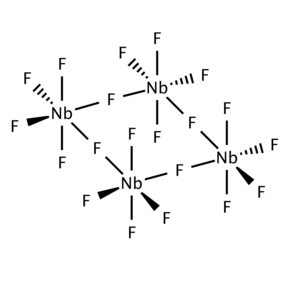Niobium(V) fluoride

| |
| Names | |
|---|---|
| IUPAC names
Niobium(V) fluoride
Niobium pentafluoride | |
| Identifiers | |
3D model (JSmol)
|
|
| ChemSpider | |
| ECHA InfoCard | 100.029.109 |
| EC Number |
|
PubChem CID
|
|
| UNII | |
CompTox Dashboard (EPA)
|
|
| |
| |
| Properties | |
Chemical formula
|
F5Nb |
| Molar mass | 187.89839 g·mol−1 |
| Appearance | colorless hygroscopic solid |
| Density | 3.293 g/cm3 |
| Melting point | 72 to 73 °C (162 to 163 °F; 345 to 346 K) |
| Boiling point | 236 °C (457 °F; 509 K) |
| reacts | |
| Solubility | slightly soluble in chloroform, carbon disulfide, sulfuric acid |
| Hazards | |
| GHS labelling: | |
 
| |
Signal word
|
Warning |
| H302, H312, H314, H332 | |
| P260, P261, P264, P270, P271, P280, P301+P312, P301+P330+P331, P302+P352, P303+P361+P353, P304+P312, P304+P340, P305+P351+P338, P310, P312, P321, P322, P330, P363, P405, P501 | |
| Flash point | Non-flammable |
| Related compounds | |
Other anions
|
Niobium(V) chloride Niobium(V) bromide Niobium(V) iodide |
Other cations
|
Vanadium(V) fluoride Tantalum(V) fluoride |
Related niobium fluorides
|
Niobium(IV) fluoride |
Except where otherwise noted, data are given for materials in their standard state (at 25 °C [77 °F], 100 kPa). | |
| Infobox references | |
Niobium(V) fluoride, also known as niobium pentafluoride, is the inorganic compound with the formula NbF5. The solid consists of tetramers [NbF5]4. It is a colorless solid that is rarely used.[1]
Preparation and reactions[]
Niobium pentafluoride is obtained by treatment of any niobium compound with fluorine:[2]
- 2 Nb + 5 F2 → 2 NbF5
- 2 NbCl5 + 5 F2 → 2 NbF5 + 5 Cl2
It reacts with hydrogen fluoride to give H2NbF7, a superacid.
Related compounds[]
In hydrofluoric acid, NbF5 converts to [NbF7]2- and [NbF5O]2-. The relative solubility of these potassium salts and related tantalum fluorides is the basis of the Marignac process for separation of Nb and Ta.
NbCl5 forms a dimeric structure (edge-shared bioctahedron) in contrast to the corner-shared tetrameric structure of the fluoride.
External links[]
References[]
- ^ Joachim Eckert, Hermann C. Starck (2005). "Niobium and Niobium Compounds". Ullmann's Encyclopedia of Industrial Chemistry. Weinheim: Wiley-VCH. doi:10.1002/14356007.a17_251. ISBN 3527306730.CS1 maint: uses authors parameter (link)
- ^ Homer F. Priest (1950). "Anhydrous Metal Fluorides". Inorganic Syntheses. Inorganic Syntheses. 3. p. 171. doi:10.1002/9780470132340.ch47. ISBN 9780470132340.
Categories:
- Niobium compounds
- Fluorides
- Metal halides